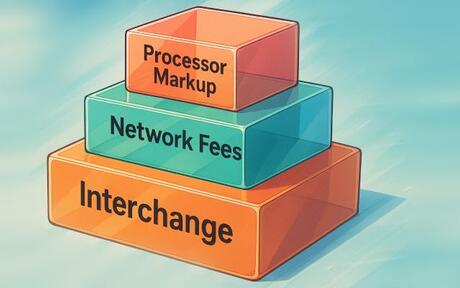Operating a high-risk business in today's digital economy presents a unique set of challenges, particularly concerning payment processing fees. These businesses, often categorized due to factors such as industry reputation, transaction characteristics, or regulatory scrutiny, face disproportionately higher costs compared to their low-risk counterparts. The complexity of fee structures, coupled with the pervasive nature of less transparent or "hidden" charges, can transform what should be a manageable operational expense into a significant financial burden. This report aims to empower business owners with a comprehensive understanding of these costs, enabling them to anticipate, analyze, and actively optimize their merchant account expenditures. By dissecting the underlying risk factors, detailing the various fee types, demystifying pricing models, and providing industry-specific benchmarks, this analysis offers actionable strategies for strategic processor selection, diligent fee management, and proactive risk mitigation. The ultimate goal is to transform this critical financial component from a source of uncertainty into a controllable element of a high-risk business's financial strategy.
Why High-Risk Businesses Face High Fees: Understanding Risk Factors
Understanding the fundamental reasons behind elevated payment processing fees is the foundational step toward effective cost management for high-risk businesses. Payment processors and financial institutions classify businesses as "high-risk" due to a confluence of factors that signal a higher potential for financial loss, fraud, or regulatory complications. These classifications directly influence the rates and terms offered, leading to significantly higher operational costs.
Industry Reputation: "Guilt by Association"
Certain industries are inherently labeled as high-risk, not necessarily due to an individual business's performance, but because of their historical association with elevated fraud rates, frequent chargebacks, or complex regulatory environments. Examples include adult entertainment, online gambling, CBD and cannabis accessories, firearms and ammunition, travel and ticketing, nutraceuticals, telemarketing, bail bonds, debt collection, and online dating services.
Even new businesses in these sectors are immediately categorized as high-risk, irrespective of their operating history or financial stability. This "guilt by association" means they face higher fees from day one, simply because of their industry's reputation. The risk potential, derived from industry trends and historical data, becomes a primary driver of initial cost.
High Chargeback Rates: A Tightrope Walk
Businesses with a history or high potential for frequent customer disputes, known as **chargebacks**, are considered significant liabilities by payment processors. A chargeback rate generally approaching or exceeding 1% of transactions is a major red flag. For high-risk merchants, the threshold for triggering penalties or increased scrutiny is stricter than for standard businesses. While a typical merchant might enter monitoring programs at a 1% chargeback ratio, high-risk merchants can face penalties or scrutiny at just 0.5%. This reduced margin for error means high-risk businesses are more susceptible to additional fees and operational challenges at lower dispute volumes.
Fraud Risk: Magnets for Malicious Activity
Certain business types are inherently more susceptible to fraudulent transactions. This is particularly true for businesses dealing with high-value products or those operating exclusively online in markets known for elevated fraud rates. The increased incidence of fraud necessitates more robust security measures and risk management protocols from processors, costs that are then passed on to the high-risk merchant through higher fees.
Legal and Regulatory Scrutiny: Navigating a Shifting Landscape
Businesses in legally ambiguous or heavily regulated fields, such as online casinos, CBD oil sellers, firearms, tobacco, or telemedicine, pose significant compliance risks for banks and processors. The evolving nature of laws and varying regional regulations in these sectors creates uncertainty for financial institutions. Regulatory compliance costs for high-risk businesses extend beyond direct fees, such as licensing and audit fees. They also necessitate significant indirect operational expenses, including continuous investment in enhanced Anti-Money Laundering (AML) and Know Your Customer (KYC) measures. This is a perpetual, evolving cost burden that impacts strategic planning and resource allocation.
International Sales & High-Ticket Transactions: Amplified Exposure
Businesses that conduct a large volume of international transactions, especially with countries known for high fraud rates, or those that regularly process high-value transactions (e.g., over $100 or $3,000 per transaction), face increased financial exposure. For high-risk businesses, high average ticket sizes can lead to significant absolute dollar losses for processors, even if the chargeback ratio remains low. The magnitude of potential financial exposure, not merely the frequency of disputes, is a key determinant of risk and a direct cause for specific financial safeguards imposed by processors.
Subscription-Based Services: The Recurring Risk
Businesses operating on recurring payment or subscription models are frequently classified as high-risk because these payment types are inherently more prone to chargebacks. This can stem from "friendly fraud" or a customer misunderstanding of terms. The inherent mechanics of subscription models, such as auto-renewals and customer difficulties with cancellation processes, directly contribute to higher chargeback potential and fraud risk. This means the billing model itself, rather than solely the product or service, is a significant determinant of high-risk classification and the associated fees.
New Businesses & Prior Account Terminations
New businesses lacking a proven track record or established financial history are often categorized as high-risk due to the absence of stability proof. Without a history of low chargebacks or consistent revenue, processors perceive a greater unknown risk. Furthermore, being listed on the MATCH (Member Alert to Control High Risk Merchants) list, a database managed by Mastercard that tracks merchants whose accounts were previously terminated, almost guarantees a high-risk classification with new providers. This is a critical, almost irreversible, determinant of high-risk status. Proactive chargeback management and maintaining an impeccable processing history are fundamental to a high-risk business's long-term viability and its very ability to access payment processing services.
Deconstructing Your Bill: A Comprehensive Breakdown of Fees
High-risk merchant account statements are notoriously complex. A granular breakdown of these fees, distinguishing between standard charges and the often-overlooked, risk-specific or "hidden" costs, is essential for effective financial management.
Standard Transaction Fees
- Processing Rates (Percentage + Per-Transaction Fee): These are the primary charges applied to each transaction. For high-risk merchants, these rates typically range from 3.5% to 6.5% of each transaction, plus a fixed amount per transaction, usually between $0.25 and $0.50. For the riskiest industries, these percentages can soar to 10% or higher. This contrasts sharply with standard business rates, which typically fall between 1.5% and 2.9%.
- Monthly Fees: A recurring charge for maintaining the merchant account, these typically range from $10 to $75. For businesses in ultra-high-risk categories, these monthly fees can be as high as $50 to $100.
- Payment Gateway Fees: These are charges for using the technology that securely transmits transaction data. These fees often range from $15 to $25 monthly.
Hidden & Risk-Specific Fees
- Chargeback Fees: Imposed each time a customer disputes a transaction, these fees are significantly higher for high-risk businesses. They typically range from $25 to $50 per incident and can escalate to $50-$75 for specific industries like adult entertainment, or even up to $100 per chargeback. Chargeback fees are a direct per-incident cost, but excessive chargebacks trigger a cascade of additional financial burdens, making chargeback prevention a critical financial imperative.
- Rolling Reserves: A percentage of a business's transactions, typically 10-20%, is held by the merchant service provider for a specified period (often 3 to 6 months). This acts as a security deposit to cover potential chargebacks, refunds, or fines. While serving as a crucial protection for the payment processor, **rolling reserves** represent a significant constraint on a high-risk business's immediate cash flow and liquidity.
- Early Termination Fee (ETF): A penalty for canceling a contract before the agreed-upon term, often ranging from $300 to $500.
- Setup/Application Fees: An initial cost to establish a merchant account, typically $100-$300. Ultra-high-risk businesses might face setup fees of $500-$1,000.
- Annual Card Network Registration Fees: Mandatory fees required by major card networks like Visa and Mastercard for certain high-risk categories. These fees range from $500 to $2,500 annually and are non-negotiable.
- Risk Monitoring Program Fees: Specific charges for the enhanced oversight and risk management programs that high-risk accounts necessitate.
- Downgrade Fees: Occur when a transaction is reclassified ("downgraded") to a higher-priced interchange category by the processor. This can add 0.5% or more to annual fees. Downgrade fees are a particularly insidious hidden cost, especially prevalent in less transparent tiered pricing models.
- Assessment Fees: Charges levied by card networks (Visa, Mastercard, etc.) on transaction volume. These can be less transparent.
- Regulatory Compliance Fees: Beyond general processing fees, high-risk businesses face specific costs for adhering to regulations, including licensing fees and frequent audit fees.
- Banking Fees: High-risk businesses may incur higher wire transfer fees and elevated account maintenance fees from some banks.
- Insurance Costs: Due to elevated risk factors, high-risk businesses often face higher liability insurance premiums.
The following table provides a comprehensive overview of potential fees for high-risk merchant accounts:
| Fee Type | Description | Typical Range for High-Risk Businesses |
|---|---|---|
| Processing Rates | Percentage of transaction + fixed fee. | 3.5% - 6.5% + $0.25 - $0.50 (can be higher) |
| Monthly Fees | Recurring charge for account maintenance. | $10 - $75 (up to $100 for ultra-high-risk) |
| Payment Gateway Fees | Charge for secure data transmission technology. | $15 - $25 monthly |
| Chargeback Fees | Fee for each customer dispute. | $25 - $50+ per incident |
| Rolling Reserves | Percentage of funds held as a security deposit. | 10% - 20% of monthly volume |
| Early Termination Fee (ETF) | Penalty for canceling a contract early. | $300 - $500 |
| Setup/Application Fees | Initial cost to establish the account. | $100 - $300 (up to $1,000 for ultra-high-risk) |
| Annual Card Network Registration Fees | Mandatory fees from Visa/Mastercard for certain industries. | $500 - $2,500 annually |
| Downgrade Fees | Extra charge when a transaction is reclassified. | Adds 0.5%+ to annual fees |
Fee Structures Demystified: Choosing the Right Model
The pricing model a high-risk merchant account provider uses profoundly impacts a business's costs and financial predictability. Understanding the mechanics, advantages, and disadvantages of each structure is crucial for strategic decision-making.
Tiered Pricing Model
Transactions are grouped into "qualified" (lowest rate), "mid-qualified" (moderate rate), and "non-qualified" (highest rate). The processor determines which transactions fall into which tier.
- Pros: Simple, easy-to-read monthly statements.
- Cons for High-Risk: Lacks transparency. Processors can unilaterally shift transactions to higher-cost tiers, hiding the true cost. This makes accurate cost comparison and budgeting difficult.
- Best for: Small businesses (< $20k/month) with predominantly card-present transactions that prioritize simplicity over cost optimization.
Interchange-Plus Pricing
This model charges the direct interchange fee (set by card networks) plus a fixed, transparent markup from the processor (e.g., interchange + 0.50% + $0.15).
- Pros for High-Risk: Offers the highest transparency. Generally results in lower overall high-risk merchant account fees for businesses with larger transaction values and provides greater visibility into which transaction types cost more.
- Cons: Statements can be more complex to decipher.
- Best for: Medium to large businesses (> $25k/month) with a diverse transaction mix, focused on cost optimization and transparency.
Flat-Rate Pricing
A single, fixed percentage plus a per-transaction fee is applied to all transactions, regardless of card type (e.g., 4.5% + $0.30).
- Pros: Extremely simple to understand and predict, making budgeting straightforward. Often comes with no separate monthly fees.
- Cons for High-Risk: Typically results in higher overall fees because it averages out all transaction costs. It doesn't scale efficiently with growth and often has volume limits.
- Best for: New high-risk businesses with unpredictable or very low sales volumes that prioritize simplicity.
Subscription Pricing (Membership Pricing)
The merchant pays a fixed monthly fee, plus the direct interchange costs and a very small per-transaction fee.
- Pros: Can lead to significant savings for high-volume businesses by eliminating percentage-based markups on large transactions. Offers transparency by passing through direct interchange rates.
- Cons: The fixed monthly fee continues during slow periods. Typically requires longer contracts with early termination fees.
- Best for: Established merchants (> $100k/month) with consistently high average ticket sizes and predictable high volumes.
Industry-Specific Fee Benchmarks
Payment processing fees vary significantly, even within the high-risk designation. Understanding these differences provides crucial benchmarks. For an established business in a "less risky" high-risk category, **credit card processing fees** typically start around 3.5%. These costs can rise to 10% or more for businesses in the riskiest industries. The average effective rate can range from 3% to 15% of their revenue.
Here is a breakdown of typical fee benchmarks for various high-risk industries:
- Adult Entertainment: "Ultra-high-risk" category. Processing rates typically range from 8-16%. Chargeback fees average $50-$75 each. Mandatory annual Visa/Mastercard registration fees can be $500-$1,000, and reserve requirements commonly reach 10-15% of monthly volume.
- CBD and Cannabis Accessories: Moderate high-risk rates, ranging from 5-9%. They also face mandatory annual Visa/Mastercard registration fees, which can be significant, ranging from $500-$2,500.
- Travel and Ticketing: Face unique fee structures due to higher reserve requirements (often reaching 15-20%) and seasonal volume penalties. Processing rates typically range from 3.5-6%.
- Online Gambling and Gaming: Another "ultra-high-risk" category. Processing rates typically range from 7-15%. Mandatory reserve requirements often fall between 10-20% of monthly volume.
The True Cost: Impact on Cash Flow, Profit, and Scalability
Beyond the individual line items on a merchant statement, high-risk merchant account fees exert profound, cascading effects on a business's overall financial health.
Impact on Cash Flow
- Rolling Reserves: These are not direct fees but a significant portion of a business's earned revenue withheld by the processor for an extended period, directly reducing immediate cash on hand.
- Longer Settlement Periods: Delays in accessing earned revenue can create liquidity bottlenecks and complicate cash flow forecasting.
- Variable Revenue Streams: Combined with unpredictable fee structures, fluctuating revenues create financial instability.
Impact on Profit Margins
- Increased Operating Costs: Elevated processing fees and penalties directly increase the cost of doing business, putting significant downward pressure on profit margins.
- Significant Revenue Drain: High-risk merchant fees can drain a substantial percentage of a business's total revenue, sometimes 3% to 15% or more.
Challenges to Business Growth (Scalability)
- Incremental Costs of Scaling: The cost of growth for high-risk businesses is not linear; it accelerates with increased volume and exposure.
- Risk Amplification with Growth: As a high-risk business grows, it typically faces increased scrutiny from processors and regulators, leading to higher auditing fees and compliance costs.
- Resource Reallocation: Escalating fees can force businesses to divert funds from strategic initiatives like marketing or product development.
Strategic Fee Optimization: Actionable Strategies
Navigating the complex world of high-risk merchant account fees requires a proactive, multi-faceted strategy to minimize costs, enhance transparency, and secure more favorable terms.
Selecting the Ideal Processor
- Specialization: Choose a payment processor that specifically specializes in your high-risk industry.
- Transparent Pricing: Demand absolute clarity on all potential costs. Favor models like interchange-plus.
- Flexible Contracts: Seek out processors offering shorter-term agreements or month-to-month options.
- Robust Tools: Prioritize providers with advanced tools for chargeback management and fraud prevention.
- Strong Support: Choose a processor that offers 24/7 customer support and dedicated account managers.
Proactive Cost Management
Negotiation Tactics:
- Leverage Volume and History: Use a clean processing history to negotiate better rates.
- Shop Around: Obtain multiple competitive quotes to use as leverage.
- Demand Explanations: Ask for a detailed explanation of every fee on your statement.
Merchant Statement Audits:
- Conduct regular, thorough audits to identify hidden or unnecessary fees, especially "downgrade fees."
Advanced Fraud & Chargeback Management:
- Utilize tools to dispute chargebacks quickly and respond promptly to notifications.
- Implement robust fraud protection tools such as 3-D Secure authentication.
- PCI Compliance: Maintain strict compliance to avoid steep fines and indirectly lower risk-based processing costs.
- Alternative Payments: Explore and incentivize alternative payment solutions such as ACH, debit cards, or even zero-fee models.
- Operational Resilience: Obtain multiple Merchant Identification Numbers (MIDs) and utilize independent tokenization services. This redundancy protects against sudden account terminations or frozen funds.
Conclusion and Recommendations
The landscape of merchant account fees for high-risk businesses is undeniably complex and often punitive. The inherent risk factors associated with certain industries directly translate into elevated costs and significant constraints on cash flow and profitability. This analysis underscores that these costs are not merely an unavoidable expense but a dynamic component that, if misunderstood or unmanaged, can severely impede a business's viability and growth.
A critical understanding emerges: the "high-risk" label is a financial reality that demands a sophisticated, proactive approach to payment processing. By embracing strategic processor selection, diligent cost analysis, proactive risk mitigation, and operational resilience, high-risk businesses can move beyond merely accepting elevated fees to actively controlling and optimizing their payment processing costs. This strategic approach fosters greater financial stability, protects profit margins, and ultimately supports sustainable growth in an inherently challenging market.
Stop overpaying for processing. Compare high-risk merchant providers now and find the best rates for your business!
Get a quick recommendation
Are you already processing credit card payments?




